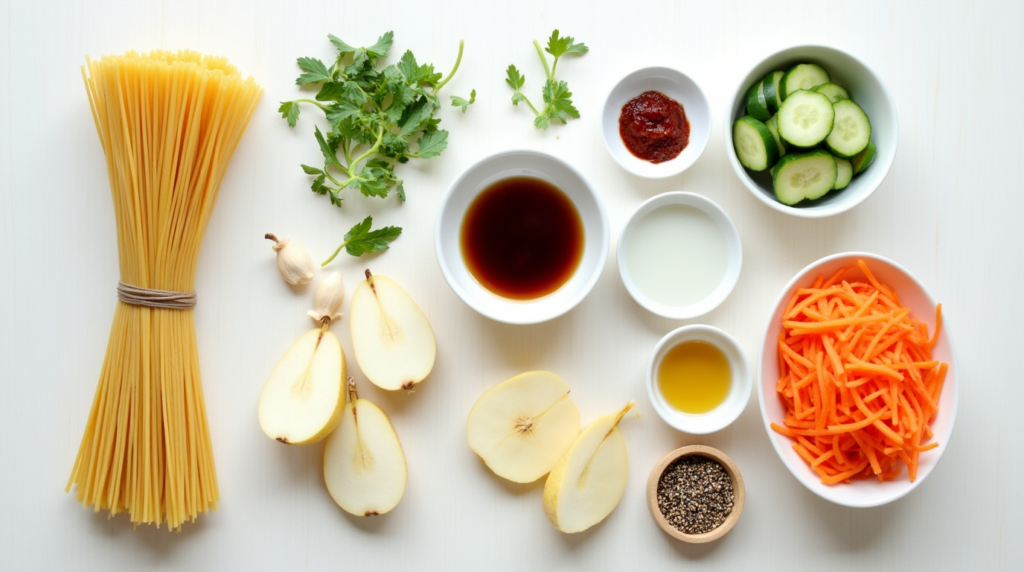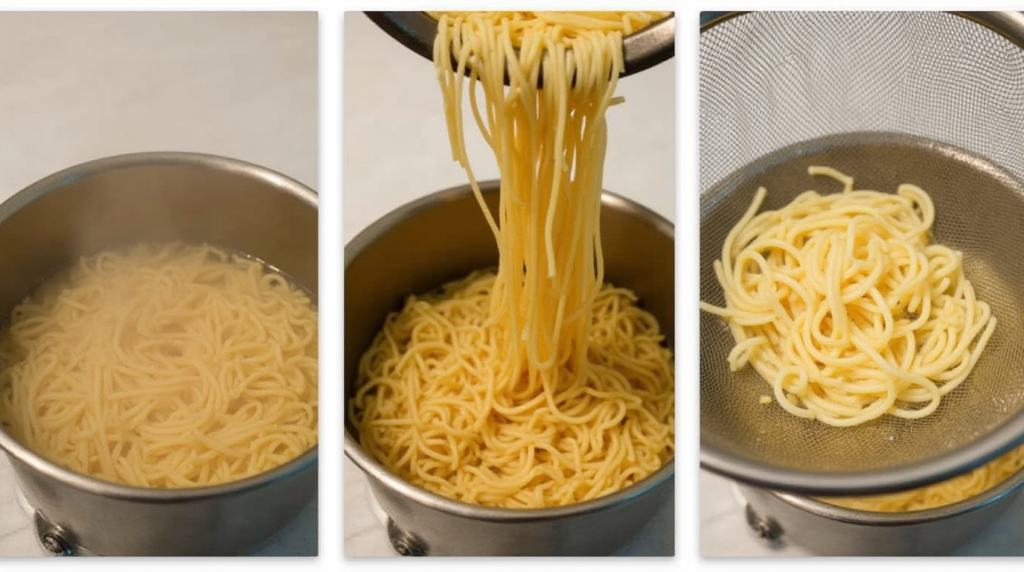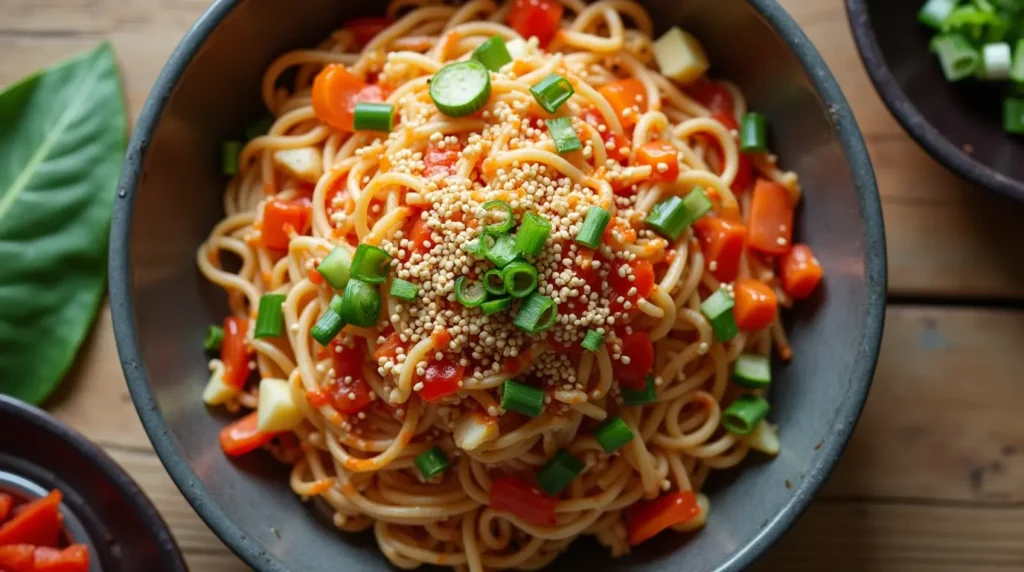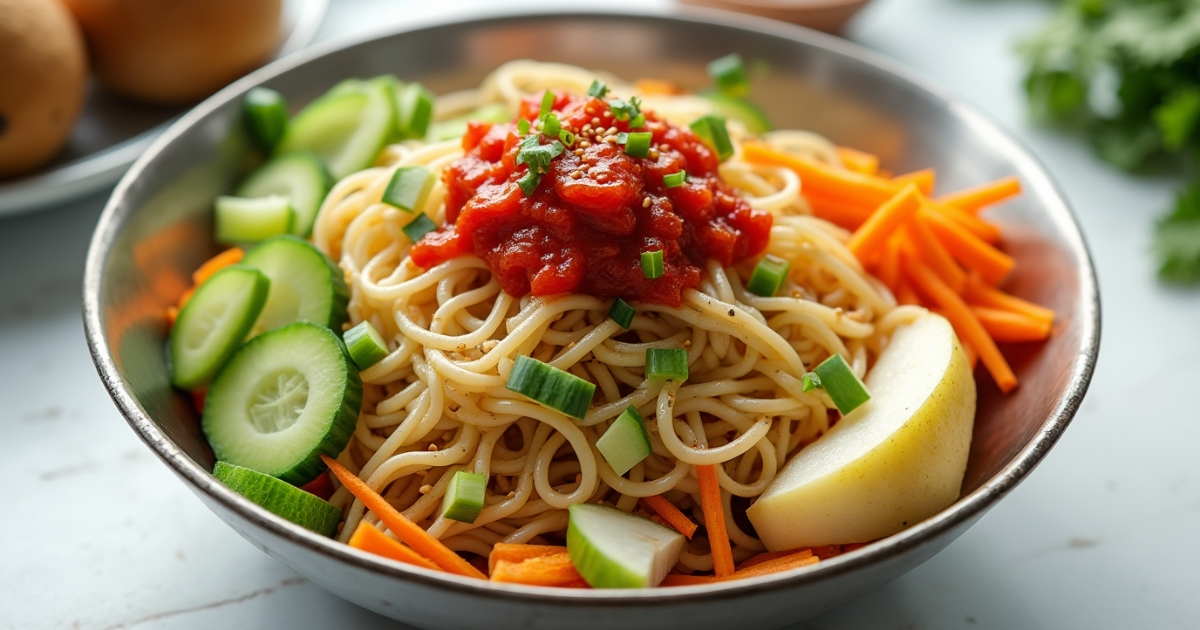Cold Bibim Noodle Salad Recipe – Spicy, Refreshing, and Easy
Beat the heat with a dish that’s both spicy and refreshing – the Cold Bibim Noodle Salad. This traditional Korean recipe, also known as bibim guksu or bibimmyeon, is a staple during the hot summer months. It’s an easy-to-make dish that combines flavorful and nutritious ingredients, making it perfect for a quick meal.
You can enjoy this delightful salad by mixing together a variety of ingredients, including noodles, vegetables, and a spicy sauce. The result is a harmonious balance of flavors and textures that will leave you wanting more.
Key Takeaways
- Easy to prepare and perfect for hot summer days
- Combines spicy and refreshing flavors
- A traditional Korean dish with nutritious ingredients
- Customizable with your favorite vegetables
- Great for a quick and healthy meal
What is Bibim Guksu?
In the heart of Korean cuisine lies Bibim Guksu, a dish that embodies the perfect blend of spicy, sweet, and tangy flavors. This cold noodle salad has become a staple in Korean cuisine, particularly during the summer months.
nYou might be wondering what makes Bibim Guksu so special. The answer lies in its rich history and cultural significance.
The Origins and Cultural Significance in Korean Cuisine
Bibim Guksu, which translates to “mixed noodles,” has its roots in traditional Korean cuisine. The dish is a reflection of Korea’s cultural heritage, where simple ingredients are transformed into a culinary masterpiece.
The cultural significance of Bibim Guksu lies in its ability to bring people together. It’s a dish often served at family gatherings and social events, promoting a sense of community and sharing.
Why This Dish is a Summer Staple in Korea
Bibim Guksu is a quintessential summer dish in Korea due to its refreshing and cooling properties. The cold noodles and spicy sauce provide a perfect respite from the sweltering heat.
The dish is also highly versatile, allowing you to customize it according to your preferences. This adaptability has contributed to its widespread popularity during the summer months.
| Aspect | Description | Significance |
|---|---|---|
| Origins | Believed to have originated in northern Korea | Reflects regional culinary traditions |
| Cultural Significance | Promotes community and sharing | Often served at social gatherings |
| Summer Staple | Refreshing and cooling properties | Provides respite from summer heat |
The Appeal of Cold Bibim Noodle Salad
The allure of Cold Bibim Noodle Salad lies in its perfect balance of spicy, sweet, and tangy flavors. This dish is not just a meal; it’s an experience that tantalizes your taste buds with every bite.
Flavor Profile: The Perfect Balance of Spicy, Sweet, and Tangy
Cold Bibim Noodle Salad is renowned for its complex flavor profile. The spicy kick from the gochugaru (Korean chili flakes) is balanced by the sweetness of the sugar and the tanginess of the vinegar, creating a harmonious taste experience. You can adjust the level of spiciness to your liking, making it accessible to a wide range of palates.
Versatility and Customization Options
One of the key appeals of Cold Bibim Noodle Salad is its versatility. You can customize it according to your dietary preferences and ingredient availability. Whether you’re vegetarian, vegan, or gluten-free, you can adapt this dish to suit your needs. The variety of vegetables and garnishes available allows you to get creative with your salad.
| Customization Option | Description |
|---|---|
| Vegetarian | Omit the meat and add more vegetables or tofu |
| Vegan | Replace the egg with tofu and use vegan-friendly sauce |
| Gluten-Free | Use gluten-free noodles and ensure the sauce is gluten-free |
Quick Preparation for Busy Weeknights
Cold Bibim Noodle Salad is a quick and easy meal to prepare, making it ideal for busy weeknights. With a preparation time of under 30 minutes, you can have a delicious, healthy meal ready in no time. The simplicity of the recipe, combined with the availability of ingredients, makes it a convenient option for a weeknight dinner.
Health Benefits of Cold Bibim Noodle Salad
Beyond its spicy and tangy flavors, Cold Bibim Noodle Salad provides a wealth of nutritional benefits that make it an excellent choice for a healthy meal. This Korean summer dish is not only refreshing but also packed with nutrients.
Nutritional Profile and Balanced Macronutrients
Cold Bibim Noodle Salad is a well-rounded dish that offers a balance of macronutrients. The noodles provide carbohydrates, which are essential for energy. The vegetables add fiber, vitamins, and minerals, while the bibim sauce contributes a small amount of protein and healthy fats.
| Ingredient | Nutritional Contribution |
|---|---|
| Noodles | Carbohydrates for energy |
| Vegetables | Fiber, vitamins, minerals |
| Bibim Sauce | Protein, healthy fats |
Digestive Benefits of Fermented Ingredients
The fermented ingredients in Cold Bibim Noodle Salad, such as kimchi or gochujang, offer significant digestive benefits. Fermentation enhances the bioavailability of nutrients and introduces beneficial probiotics into the dish. These probiotics support gut health, aiding in digestion and boosting the immune system.
By incorporating Cold Bibim Noodle Salad into your diet, you can enjoy not only its delicious flavors but also its numerous health benefits, making it a great addition to your easy cold noodle salad repertoire.
Essential Ingredients for Authentic Cold Bibim Noodle Salad
Creating the perfect Cold Bibim Noodle Salad begins with understanding its essential ingredients. To make this dish, you’ll need a combination of high-quality noodles, a flavorful bibim sauce, and a variety of fresh vegetables and traditional garnishes.

Choosing the Right Noodles: Somyeon vs. Buckwheat vs. Rice Noodles
The type of noodles used in Cold Bibim Noodle Salad can significantly impact the dish’s overall flavor and texture. Traditionally, Koreans use somyeon (thin wheat flour noodles) or buckwheat noodles. Somyeon provides a light, delicate texture, while buckwheat noodles offer a nuttier flavor and chewier texture. Rice noodles are also a popular alternative for those looking for a gluten-free option.
When choosing the right noodles, consider the flavor profile you prefer. If you want a more traditional taste, somyeon might be the best choice. For a nuttier flavor, buckwheat is ideal. If you’re catering to dietary restrictions, rice noodles are a great alternative.
The Perfect Bibim Sauce Components
The bibim sauce is a crucial component of Cold Bibim Noodle Salad, providing the dish with its signature spicy, sweet, and tangy flavors. The sauce typically consists of a mixture of gochujang (Korean chili paste), vinegar, sugar, soy sauce, and garlic. Some recipes may also include additional ingredients like sesame oil or ginger to enhance the flavor.
To make the perfect bibim sauce, balance is key. You want to achieve a harmonious blend of spicy, sweet, and sour flavors. Adjusting the proportions of the ingredients can help you tailor the sauce to your taste preferences.
Fresh Vegetables and Traditional Garnishes
Fresh vegetables and traditional garnishes add texture, flavor, and visual appeal to Cold Bibim Noodle Salad. Common ingredients include cucumber, carrots, pear slices, and boiled egg. Some recipes also call for julienned radish or zucchini for added crunch.
Garnishes like toasted sesame seeds and chopped green onions not only add flavor but also enhance the dish’s presentation. Feel free to get creative with your choice of vegetables and garnishes to suit your taste and dietary needs.
Equipment You’ll Need
The right equipment can make all the difference when preparing Cold Bibim Noodle Salad. Having the proper tools and vessels not only simplifies the preparation process but also enhances the overall dining experience.
Essential Kitchen Tools for Preparation
To prepare Cold Bibim Noodle Salad, you’ll need a few essential kitchen tools. A large pot is necessary for boiling the noodles, while a colander is required for draining them. A cutting board and a sharp knife are needed for preparing the various vegetables. Additionally, a mixing bowl is essential for combining the ingredients and making the bibim sauce. A measuring cup and spoons will help you achieve the perfect balance of flavors.
Traditional and Modern Serving Vessels
The presentation of Cold Bibim Noodle Salad is just as important as its taste. Traditionally, Korean cold noodle salad is served in a metal bowl, which keeps the ingredients cool. However, modern serving vessels like glass or ceramic bowls can also be used, adding a touch of elegance to the dish. Whichever vessel you choose, ensure it’s large enough to hold all the ingredients and allows for easy mixing.
Step-by-Step Cold Bibim Noodle Salad Recipe
Now that we’ve covered the basics of Cold Bibim Noodle Salad, it’s time to dive into the step-by-step recipe. This dish is a perfect blend of spicy, sweet, and tangy flavors, making it a staple in Korean cuisine during the summer months.
Preparing the Noodles to the Perfect Texture
The first step in making Cold Bibim Noodle Salad is cooking the noodles. You can use somyeon, buckwheat, or rice noodles, depending on your preference. Cook the noodles according to the package instructions until they are al dente. Typically, somyeon noodles take about 4-5 minutes to cook. Once cooked, drain the noodles in cold water to stop the cooking process and remove excess starch. This step is crucial for achieving the perfect texture.

Making the Authentic Bibim Sauce
The bibim sauce is the heart of Cold Bibim Noodle Salad, providing the signature spicy, sweet, and tangy flavor. To make the sauce, you’ll need gochujang (Korean chili paste), soy sauce, rice vinegar, sugar, garlic, and sesame oil. Combine these ingredients in a bowl and mix until smooth. Adjust the spice level to your liking by adding more or less gochujang. The sauce should be thick enough to coat the noodles evenly but still be pourable.

Preparing the Vegetables and Garnishes
While the noodles are cooking and the sauce is being prepared, you can start on the vegetables and garnishes. Thinly slice cucumbers, carrots, and pear (if using). You can also add other vegetables like bean sprouts or zucchini. For garnishes, toasted sesame seeds and chopped green onions add a nice crunch and flavor.
Assembling Your Cold Bibim Noodle Salad
To assemble the salad, place the cooked noodles in a large bowl. Arrange the sliced vegetables on top of the noodles in a visually appealing manner. Drizzle the bibim sauce over the vegetables and noodles. Finally, sprinkle toasted sesame seeds and chopped green onions over the top. Serve immediately, or refrigerate for up to an hour before serving to allow the flavors to meld together.

By following these steps, you’ll have a delicious and refreshing Cold Bibim Noodle Salad that’s perfect for hot summer days.
Customizing Your Cold Bibim Noodle Salad
Customizing your Cold Bibim Noodle Salad is easy and fun, enabling you to adjust the dish according to your dietary needs and flavor preferences. This adaptability is one of the key reasons why bibim guksu remains a beloved dish in Korean cuisine.
Adjusting the Spice Level for Different Palates
One of the most common customizations for Cold Bibim Noodle Salad is adjusting its spice level. The spicy kick comes from the gochugaru (Korean chili flakes) in the bibim sauce. For a milder version, you can reduce the amount of gochugaru or omit it altogether. Conversely, if you prefer a spicier salad, you can add more gochugaru or incorporate other spicy elements like diced jalapeños or serrano peppers.
For those who are new to spicy foods, starting with a small amount of gochugaru and gradually increasing it is a good strategy. This approach allows you to become accustomed to the heat without overwhelming your taste buds.
Vegetarian, Vegan, and Gluten-Free Adaptations
Cold Bibim Noodle Salad can easily be adapted to suit various dietary requirements. For a vegetarian version, you can simply omit any meat or animal-derived ingredients. To make it vegan, replace the traditional use of egg garnish with alternatives like tofu or additional vegetables, and ensure that the bibim sauce is free from animal products.
For a gluten-free adaptation, focus on using gluten-free noodles such as rice noodles or buckwheat noodles, which are naturally gluten-free. Always check the ingredient labels to ensure that all components, including the sauce and any added condiments, are gluten-free.
Adding Protein: Traditional and Modern Options
While traditional Cold Bibim Noodle Salad often includes boiled egg and sometimes sliced meat, you can customize the protein content to your liking. For added protein, consider incorporating boiled chicken, tofu, or even seafood like boiled shrimp or crab.
- Boiled chicken or turkey for a lean protein boost
- Marinated and grilled tofu for a vegan protein source
- Sliced boiled eggs for a traditional touch
- Boiled or grilled shrimp for a seafood twist
By incorporating these protein sources, you not only enhance the nutritional value of your Cold Bibim Noodle Salad but also make it more satisfying and filling.
Regional Variations of Cold Bibim Noodle Salad
As you explore Cold Bibim Noodle Salad, you’ll discover that regional twists add a new layer of flavor to this traditional dish. The variations are a testament to the rich culinary diversity across different regions of Korea.
Northern vs. Southern Korean Styles
The difference between Northern and Southern Korean styles of Cold Bibim Noodle Salad is primarily reflected in the ingredients and the level of spiciness. Northern regions tend to use less spicy bibim sauce, focusing more on the natural flavors of the ingredients. In contrast, Southern Korean versions are often spicier and more flavorful, incorporating ingredients like gochugaru (Korean chili flakes) generously.
The choice of noodles also varies. While somyeon (thin wheat flour noodles) is popular across the country, buckwheat noodles are more commonly used in certain regions for their distinct nutty flavor. This regional preference significantly affects the overall taste and texture of the dish.
Modern Fusion Interpretations
In recent years, chefs have been experimenting with modern fusion interpretations of Cold Bibim Noodle Salad, blending traditional Korean flavors with international ingredients. Examples include adding truffle oil for a luxurious twist or incorporating kimchi made with locally sourced ingredients for a unique flavor profile.
Some modern recipes also cater to diverse dietary preferences by substituting traditional ingredients. For instance, vegan versions replace the usual egg garnish with marinated and grilled portobello mushrooms, while gluten-free adaptations use rice noodles or other gluten-free alternatives.
These regional and modern variations not only keep the traditional Cold Bibim Noodle Salad relevant but also introduce it to a wider audience, showcasing the versatility and adaptability of Korean cuisine.
Serving Suggestions and Traditional Pairings
When serving Cold Bibim Noodle Salad, consider enhancing the meal with traditional Korean side dishes and refreshing beverages. This beloved Korean summer dish is not only a delight on its own but also becomes an even more satisfying meal when paired with the right accompaniments.
Banchan (Side Dishes) to Serve Alongside
To create a well-rounded Korean-inspired meal, you can serve Cold Bibim Noodle Salad with a variety ofbanchan, or side dishes. Some popular options include kimchi, a spicy fermented vegetable dish that adds a bold flavor, andkongnamul muchim, a seasoned soybean sprout salad that provides a refreshing contrast. Other choices might beoi muchim, a cucumber salad dressed with a spicy and sour sauce, ordanmuji, thinly sliced radish kimchi that adds a nice crunch.
As you select your banchan, consider the balance of flavors and textures you want to achieve. A mix of spicy, sour, sweet, and salty flavors, along with varying textures, will enhance the overall dining experience.
Beverage Pairings: From Traditional Korean Drinks to Modern Options
For beverage pairings, you can choose from a range of traditional Korean drinks or modern options.Mugicha, a roasted barley tea, is a popular choice to pair with Cold Bibim Noodle Salad, as its slightly bitter taste helps cut through the richness of the dish. Alternatively, you might enjoymakgeolli, a traditional Korean rice wine that offers a creamy texture and subtle sweetness. For a more modern twist, consider serving your Cold Bibim Noodle Salad with a refreshing sparkling water infused with fruits like citrus or cucumber, or a light, crisp beer.
As stated by a Korean cuisine expert, “The art of pairing beverages with Korean dishes lies in finding harmony between flavors and textures.” This principle can guide your choices when selecting drinks to accompany your Cold Bibim Noodle Salad.
“The perfect meal is not just about the main dish, but about the overall experience created by the combination of flavors, textures, and beverages.”
By thoughtfully selecting banchan and beverages, you can elevate your Cold Bibim Noodle Salad experience and enjoy a truly authentic Korean meal.
Conclusion
You now have the knowledge to create an authentic cold bibim noodle salad, a refreshing noodle salad that’s perfect for hot summer days. This easy cold noodle salad recipe allows you to enjoy a delicious and healthy meal with minimal preparation time.
By following the steps outlined in this article, you can experience the perfect balance of spicy, sweet, and tangy flavors that this dish has to offer. Feel free to customize the recipe to suit your taste preferences, exploring various options such as adjusting the spice level or adding different proteins.
As you’ve learned, cold bibim noodle salad is not only a tasty meal but also a nutritious one, offering a balanced mix of macronutrients and digestive benefits from fermented ingredients. With its versatility and ease of preparation, this refreshing noodle salad is sure to become a staple in your culinary repertoire.
FAQ
What is Cold Bibim Noodle Salad?
Cold Bibim Noodle Salad, also known as Bibim Guksu, is a popular Korean cold noodle dish made with noodles, vegetables, and a spicy bibim sauce, perfect for hot summer days.
What type of noodles are best for Cold Bibim Noodle Salad?
You can use somyeon, buckwheat, or rice noodles for Cold Bibim Noodle Salad. Somyeon is a traditional choice, while buckwheat noodles add a nutty flavor, and rice noodles provide a gluten-free option.
How do I adjust the spice level in Cold Bibim Noodle Salad?
To adjust the spice level, you can modify the amount of gochugaru (Korean chili flakes) or gochujang (Korean chili paste) in the bibim sauce. For a milder flavor, reduce or omit these ingredients.
Can I make Cold Bibim Noodle Salad vegan or gluten-free?
Yes, you can make Cold Bibim Noodle Salad vegan by substituting the traditional sauce ingredients with vegan alternatives, such as vegan gochujang. For a gluten-free version, use gluten-free noodles and be mindful of the sauce ingredients.
What are some common variations of Cold Bibim Noodle Salad?
Variations include different regional styles, such as Northern and Southern Korean versions, and modern fusion interpretations that incorporate unique ingredients or flavors.
How do I serve Cold Bibim Noodle Salad traditionally?
Traditionally, Cold Bibim Noodle Salad is served with banchan (side dishes) like kimchi, and paired with beverages such as makgeolli (traditional Korean rice wine) or iced tea.
Can I customize Cold Bibim Noodle Salad with protein?
Yes, you can add protein sources like sliced beef, boiled egg, or tofu to enhance the dish. Traditional options include sliced cucumbers, pear slices, and boiled egg.
Is Cold Bibim Noodle Salad a healthy dish?
Cold Bibim Noodle Salad is a nutritious and balanced meal, featuring a mix of carbohydrates, proteins, and vegetables, along with the digestive benefits of fermented ingredients like kimchi.
How long does it take to prepare Cold Bibim Noodle Salad?
Preparation time is relatively quick, typically taking about 30-40 minutes to prepare the noodles, sauce, and vegetables, making it a great option for busy weeknights.
Leave a Review & Rate This Recipe!
There are no reviews yet. Be the first one to write one.

